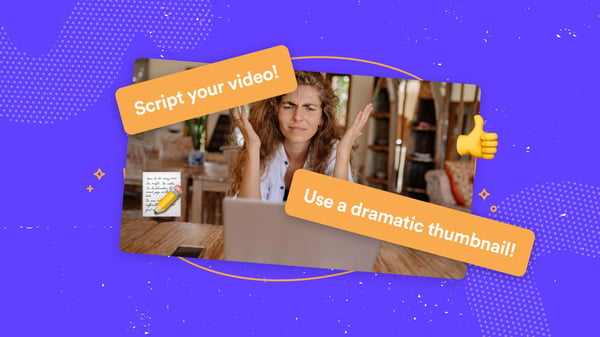How do you get a prospect who has ghosted you to re-engage?
In this article, using a real-life example, I'm going to share my approach to using video to make it easier for busy prospects to come back into the sales conversation when everything else seems more interesting than you.
Think about it…if you’ve finally got an elusive prospect to take a bite out of your outbound message, remember they're engaging with you amid 1,001 other things.
So it makes sense why they may ghost you or cancel a meeting without notice. Call it "meeting" remorse if you will. You send a salvage video to bring their mind back to the problem you introduced them to in your initial outreach and its impact. Here's how.
Find a Trigger
Think of a trigger as an action/publicly observable sign that your prospect might be experiencing the problem you're solving for.
In my case, I was using companies hiring salespeople on LinkedIn as a trigger to pitch business process documentation as a service.
My thesis was that companies hiring sales development representatives are probably training them and trying to transfer their existing (quota-hitting) reps' best practices onto the new reps. My solution was meant to ease this process.
Find a trigger for your product, it'll strengthen the impact of your salvage video.
Triggers can include...
- open jobs
- info on prospects’ websites, e.g. testimonials
- news related to the problem you solve
- prospects’ live ads (use FB ad Library or check the posts section of their LinkedIn page)
With this info in hand, create your script.
Script Your Salvage Video
Here’s how I approached this when a prospect who’d responded positively to my initial outreach (and asked for the meeting) cancelled the meeting on D-day without an explanation.
The original trigger that made me reach out to this prospect was noticing that they were hiring SDRs on LinkedIn. However, for a salvage video, I felt this really didn’t capture the problem I wanted to solve for them.
So I searched for a new trigger: went through their website and found a customer testimonial that captured the problem perfectly and used that in my script. (Here's a deep dive on triggers if you want to learn how to identify them for better videos or copy)
The script:
Hi , here's why I reached out.
I saw this comment from who's been working with you for probably a year now.
She says she had tried a few other SDRs from your team before she finally found the right SDR that manages to reach her monthly target.
This is where documenting a rep's best practices as Standard Operating Procedures helps.
If you look at the process used by the SDR liked working with vs the others that didn't meet her targets.
You'll notice slight differences in their processes.
What I do is record ’s favourite SDRs workflow and explanations of how they think.
And turn it into SOP that the other SDRs can learn from—even the new ones.
If you're ever interested in doing something like this…
Here's a breakdown of the script's structure:
- Why I reached out: reference trigger/problem
- Put a spotlight on the problem: share a real-life example if possible
- A summary of your approach to solving that problem (weave in customer story if appropriate)
- Call to action
(See 8 video script examples for sales outreach)
As I was crafting this script I was doing it under the following assumptions–they dictated why I structured it the way I did. Prospect cancelled/ghosted because
- They looked at the meeting with fresh eyes and they discovered that they really didn't need to have this conversation. (Meeting remorse)
- Something else came up that had nothing to do with me.
- They couldn’t even remember who I was, and why I was on their calendar. Probably cause they are extremely busy people.
Here's the formula for crafting something similar.
Identify and Focus on a Specific Problem
Think back to the moments in your past discovery calls where you identified a prospect’s problem and they agreed with you.
What is your typical prospect's problem and its impact (on revenue, team, etc)? Mention that. If you can use prospects' words from call transcripts to explain it, the better.
This can either be a technical problem, e.g. our reps are taking too long to ramp up. Or a business problem: we're losing money and deals when our reps take over 6 months to ramp.
Make this the central theme of your script and follow the salvage video structure I’ve described above.
Create a Dramatic Thumbnail
Here's mine and why I used it:
(Note: Sendspark has a feature to easily create personalized video thumbnails)
I realized that my prospect had to be intrigued by something to click on my salvage video—assuming they'd lost interest in me. So a striking thumbnail was vital.
A dramatic thumbnail stems from the concept of "show don't tell"... that the impact of our messaging is increased when you can show as well as tell.
Hence why the screenshot of every salvage video has to either show the problem you're looking to solve for them, the impact of that problem when not solved, or the result of solving that problem (think about the before-and-after pics used on weight loss products).
Here's a rule to remember:
Use something about them; people are more interested in themselves than you
It can either be a screenshot of something on their website, e.g. one of their customers—like I did. Or if you're selling training products, for example, take a screenshot of one of their employees who might benefit from your training. Screenshot a competitor... (think of anything that's top of mind to your prospect and use it)
You can create a reusable dramatic thumbnail template, with annotations, etc where you just add screenshots from different prospects and you’d be ready to fire.
Salvage Email
In the email accompanying your salvage video, ensure you don't come across as if you're blaming or shaming them for not showing up. Here's what I used and why:
Notice how I tried to keep the email copy’s focus on them.
I found the employees affected by the problem I wanted to solve (these were new reps who were probably undergoing training). And structured the message so that it felt like my focus was 100% on them. I also used the same technique on the video caption: the right caption can increase viewership.
Nothing to do with me, my product and why I wanted another meeting.The prospect watched the video and got back to me.
It does not always work out this way in every salvage video, but what you want is re-engagement, even if the answer is "go kick rocks" or "talk to Mary in Engineering."
Remember to keep the salvage videos short; less than five minutes (mine was 1 minute and 12 seconds). Depending on your style, as a call to action, you can hint at another meeting or ask a question. PS: I didn’t ask for a meeting in my video but the prospect still offered to reschedule the call, so either works.
The service I was pitching was simple (can be closed in one call), so I structured my salvage video to match that,e.g. included pricing in the video. But if you're selling more complex products/services, adapt accordingly.
All in all, the aim of a salvage video is to get the conversation going again. Hope this helps. Try it and tell us how it worked out for you. For more insight on using video when prospecting, here are 11 video prospecting examples worth copying.




